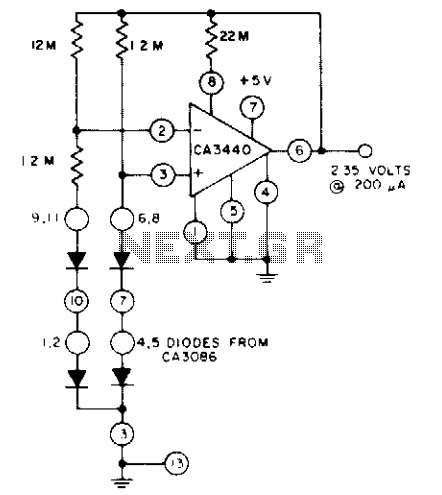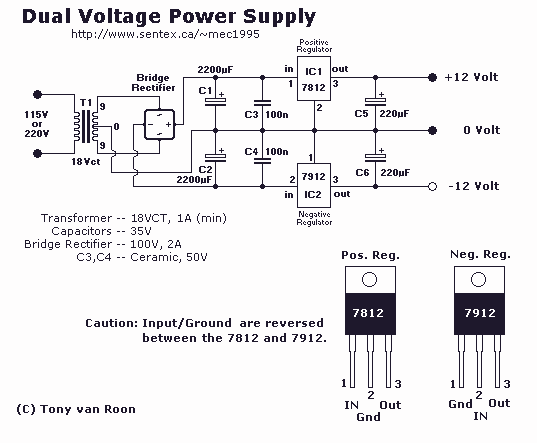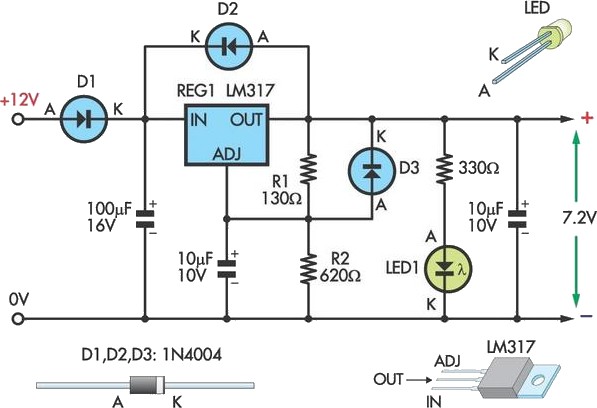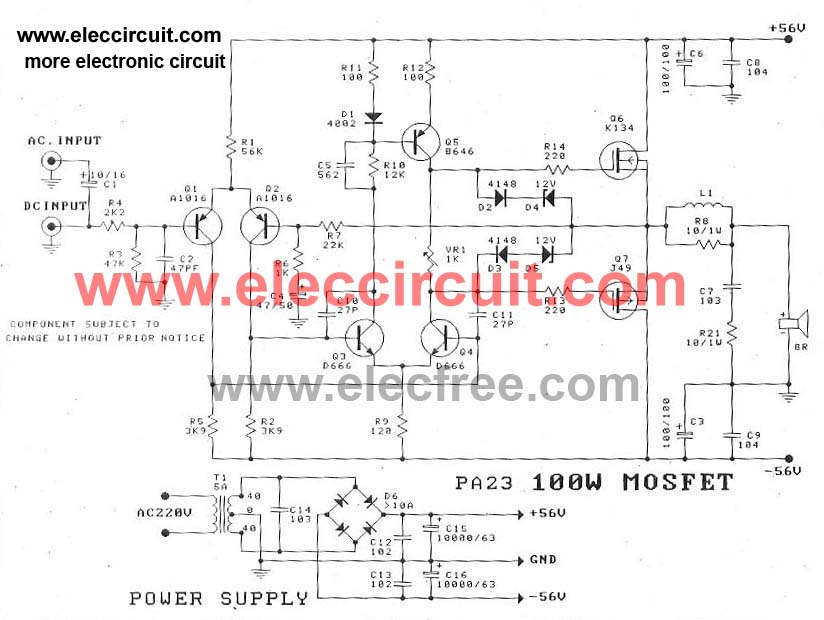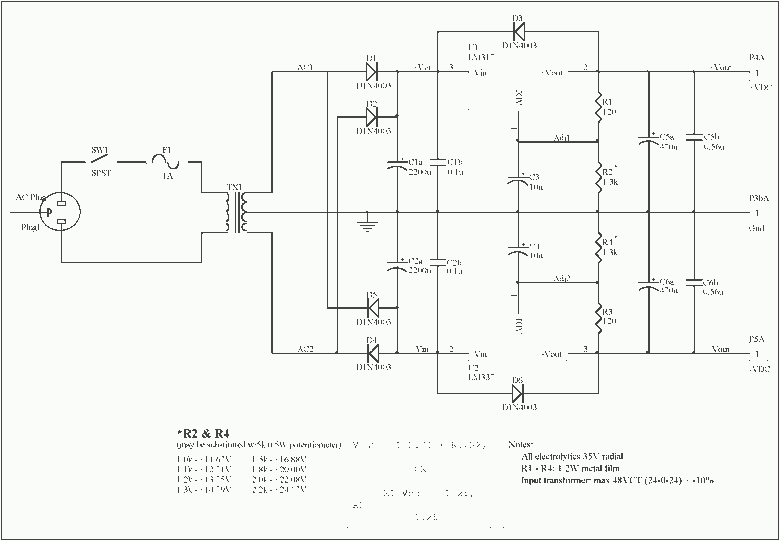
3-30V 3A Adjustable Regulated DC Power Supply
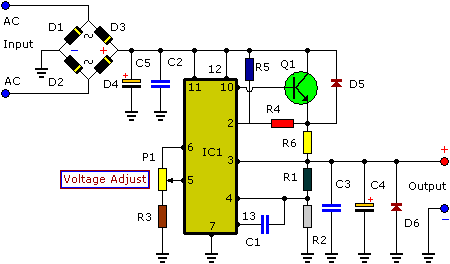
This power supply is designed as either an auxiliary or a permanent power supply for various common circuits that require a stabilized DC voltage ranging from 3 to 30V, provided that the current consumption does not exceed 3A. Additionally, this power supply unit can serve other applications. By replacing the trimmer with a potentiometer, it can be utilized as an adjustable power supply. A high-quality heatsink is essential for this circuit. If the circuit is to be integrated into another housing, it must include ventilation holes, which can be created manually, to facilitate the dissipation of generated heat.
This power supply circuit is engineered to deliver a reliable and adjustable DC voltage output suitable for various electronic applications. The design incorporates a voltage regulation mechanism, typically utilizing a linear voltage regulator or a switching regulator, to maintain a stable output voltage despite variations in load current or input voltage.
The circuit's operational range of 3 to 30V allows for versatility, making it applicable for powering microcontrollers, sensors, and other electronic devices that require specific voltage levels. The maximum output current of 3A ensures that it can comfortably drive devices with moderate power requirements.
To enhance the functionality of the power supply, the inclusion of a potentiometer in place of a fixed trimmer allows users to easily adjust the output voltage according to their specific needs. This feature is particularly beneficial in experimental setups or when powering devices with varying voltage requirements.
Thermal management is a critical aspect of this design. A quality heatsink must be employed to dissipate heat generated by the voltage regulation process, especially under higher load conditions. The heatsink should be appropriately sized to ensure that the temperature of the regulator remains within safe operating limits, thereby prolonging the lifespan of the components and maintaining reliability.
For installations where the power supply circuit is housed in an enclosure, it is imperative to incorporate ventilation holes. These holes facilitate airflow and heat dissipation, preventing overheating of the components. Proper placement and sizing of these ventilation holes are crucial to ensure effective cooling.
In summary, this power supply circuit provides a stable and adjustable output voltage, suitable for a wide range of electronic applications, while emphasizing the importance of thermal management and ventilation in its design.This power supply is meant as an auxiliary or as a permanent power supply for all common circuits based on a stabilized DC voltage between 3 and 30V provided that the consumption does not exceed 3A. Of course this power supply unit can also be used for other purposes. Be replacing the trimmer by a potentiometer, it may even be used as an adjustabl e power supply unit. A good quality heatsink must be used. If the circuit is to be integrated into another housing, it must be provided with ventilation holes (one may make these holes oneself), necessary for the release of the heat developed. Be the first of your friends to get free diy electronics projects, circuits diagrams, hacks, mods, gadgets & gizmo automatically each time we publish.
Your email address & privacy are safe with us ! 🔗 External reference
This power supply circuit is engineered to deliver a reliable and adjustable DC voltage output suitable for various electronic applications. The design incorporates a voltage regulation mechanism, typically utilizing a linear voltage regulator or a switching regulator, to maintain a stable output voltage despite variations in load current or input voltage.
The circuit's operational range of 3 to 30V allows for versatility, making it applicable for powering microcontrollers, sensors, and other electronic devices that require specific voltage levels. The maximum output current of 3A ensures that it can comfortably drive devices with moderate power requirements.
To enhance the functionality of the power supply, the inclusion of a potentiometer in place of a fixed trimmer allows users to easily adjust the output voltage according to their specific needs. This feature is particularly beneficial in experimental setups or when powering devices with varying voltage requirements.
Thermal management is a critical aspect of this design. A quality heatsink must be employed to dissipate heat generated by the voltage regulation process, especially under higher load conditions. The heatsink should be appropriately sized to ensure that the temperature of the regulator remains within safe operating limits, thereby prolonging the lifespan of the components and maintaining reliability.
For installations where the power supply circuit is housed in an enclosure, it is imperative to incorporate ventilation holes. These holes facilitate airflow and heat dissipation, preventing overheating of the components. Proper placement and sizing of these ventilation holes are crucial to ensure effective cooling.
In summary, this power supply circuit provides a stable and adjustable output voltage, suitable for a wide range of electronic applications, while emphasizing the importance of thermal management and ventilation in its design.This power supply is meant as an auxiliary or as a permanent power supply for all common circuits based on a stabilized DC voltage between 3 and 30V provided that the consumption does not exceed 3A. Of course this power supply unit can also be used for other purposes. Be replacing the trimmer by a potentiometer, it may even be used as an adjustabl e power supply unit. A good quality heatsink must be used. If the circuit is to be integrated into another housing, it must be provided with ventilation holes (one may make these holes oneself), necessary for the release of the heat developed. Be the first of your friends to get free diy electronics projects, circuits diagrams, hacks, mods, gadgets & gizmo automatically each time we publish.
Your email address & privacy are safe with us ! 🔗 External reference
